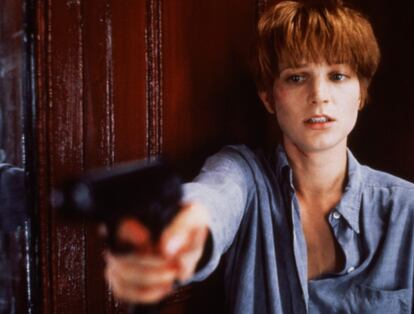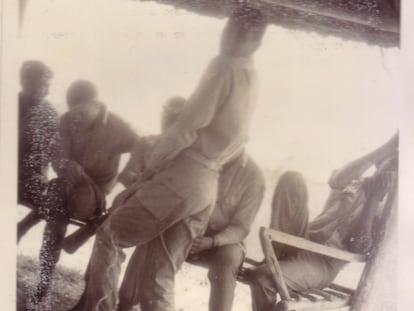Killer lesbians and bisexuals: How cinema has promoted a misogynistic and homophobic archetype
Francina Ribes Pericàs analyzes the reasons why Hollywood has repeatedly associated female homosexuality with violence

Thirty years ago, several American LGTBQ+ associations staged demonstrations outside movie theaters to protest the perverse and unrealistic image that Basic Instinct offered of homosexuality and bisexuality. To no avail: Paul Verhoeven’s feature film grossed more than $350 million, mainly because of the racy scenes enacted by Sharon Stone. Decades later, the debate continues to rage over whether it is one of the most misogynistic films of all time or, on the contrary, a great parody of male misogyny. But, watching it again, it is undeniable that all the female characters are not just alleged killers, but alleged lesbian or bisexual serial killers.
Since the 1980s – and especially the 1990s with the rise of neo-noir – Hollywood has associated female homosexuality with violence in general and murder in particular. Why? Some possible answers can be found in Absence and Excess. Lesbians and bisexual murderers in Hollywood films, an essay by Francina Ribes Pericàs, from the Autonomous University of Barcelona. Also a member of the band Doble Pletina, Ribes Pericàs analyzes the origin of this stereotype, which has taken over from the femme fatale of classic film noir and the vampires of the fantasy genre.
“It all came from an intuition I had about 10 years ago,” she says. “As a film buff, I noticed that, in one way or another, the theme of murder was recurrent. There are those who commit murder because they are villains and can thus be demonized before the end credits, which happens in Single White Woman, and others who, in the case of Heavenly Creatures, kill as a radical form of self-vindication, to rebel against the environment that oppresses them. Besides the fact that lesbian culture has been rendered invisible in mainstream cinema, on the few occasions that it has been depicted, it tends to be represented from a hetero-patriarchal perspective and repeatedly linked to violence. Even now.”
At the beginning of the 20th century, before the rise of Nazism, Girls in Uniform – the first feature film with a lesbian plot – was released in Germany, but still Hollywood strongly condemned women who posed a threat to men. There is the archetype of the vampire, personified by the actress Theda Bara, a symbol of female rebelliousness that irritated the conservative classes, particularly the men. No wonder that, in an interview Bara gave to the publication Theatre Magazine in 1917, she said: “Women are my greatest admirers because they see in my vampire revenge for unavenged offenses... I have the face of a vampire, perhaps, but the heart of a feminist.”
In the period from 1929 to 1934, actresses such as Norma Shearer, Mae West and Marlene Dietrich depicted strong, sexual and empowered characters in films with clear references to homosexuality. As early as 1933, Queen Christina, a film starring Greta Garbo, dealt with bisexuality in a very natural way.
However, that fleeting glimpse of open-mindedness was cut short in 1934 when the Motion Picture Production Code, better known as the Hays Code, came into force. Its implementation led to the prohibition of explicit allusions to homosexuality until 1967; women were relegated to submissive roles and characters with unorthodox behavior were portrayed in a negative light. The backlash was evident.
It would not be until the 1940s and 1950s, with the emergence of film noir, that theaters would once again recover intelligent and powerful female protagonists, symbolically linked to violence and sex: the femme fatales. Their characterization was ambiguous. However, as Ribes Pericàs explains: “Given the Hays code, the art of codification was key in this film genre. Femme fatales are not characterized by their lesbianism, but they posed a threat to the hero, since their victims were men. Unlike in the pre-censorship years, there was no chance of them getting a happy ending. Although the interesting thing is that, regardless of the negative connotations attached to their characters, they had the ability to seduce men and women equally.”
Once the Hays Code was ditched in 1967, the change was immediate. But not for the better. “There was a need to make everything more explicit and provocative,” says Ribes Pericàs. “Sexploitation emerged, with subgenres like women in prison – groups of incarcerated women suffering all kinds of abuse – and erotic horror films about lesbian vampires, heavily influenced by porn. In short, the sexual fantasies of heterosexual men were given a voyeuristic twist.”
The same thing happened in the 1990s with neo-noir. The femme fatales of Basic Instinct or Wild Things are markedly more evil and sexual than those of classic film noir. But for the first time they were getting away with it and were not condemned to an inevitable disastrous outcome. Of course, this was after being filmed in scenes of gratuitous nudity and spilling just the right amount of blood: two elements that work wonders at the box office.
But there are exceptions. The best example is Bound, the neo-noir movie by the Wachowski Sisters in 1996: “It does exude a sensibility that goes far beyond what is usual in the mainstream,” says Ribes Pericàs. “The Wachowskis, who were not yet transgender women when they shot it, asked writer Susie Bright to advise them on how to shoot several scenes. Regarding how it depicts lesbian love and sex, how the characters are constructed and its happy ending, it is probably the best of all the films analyzed in the book.”
“Subjectivity is essential,” adds Ribes Pericàs. “In recent years, outstanding movies have been shot outside Hollywood, such as Carol or Portrait of a Lady on Fire, which both deal with female homosexuality. But it’s still not enough. If there aren’t more women, lesbians and bisexuals behind the cameras, it’s hard to get the representation right. There’s still a long way to go.”
Tu suscripción se está usando en otro dispositivo
¿Quieres añadir otro usuario a tu suscripción?
Si continúas leyendo en este dispositivo, no se podrá leer en el otro.
FlechaTu suscripción se está usando en otro dispositivo y solo puedes acceder a EL PAÍS desde un dispositivo a la vez.
Si quieres compartir tu cuenta, cambia tu suscripción a la modalidad Premium, así podrás añadir otro usuario. Cada uno accederá con su propia cuenta de email, lo que os permitirá personalizar vuestra experiencia en EL PAÍS.
¿Tienes una suscripción de empresa? Accede aquí para contratar más cuentas.
En el caso de no saber quién está usando tu cuenta, te recomendamos cambiar tu contraseña aquí.
Si decides continuar compartiendo tu cuenta, este mensaje se mostrará en tu dispositivo y en el de la otra persona que está usando tu cuenta de forma indefinida, afectando a tu experiencia de lectura. Puedes consultar aquí los términos y condiciones de la suscripción digital.
More information
Últimas noticias
Most viewed
- Sinaloa Cartel war is taking its toll on Los Chapitos
- Oona Chaplin: ‘I told James Cameron that I was living in a treehouse and starting a permaculture project with a friend’
- Reinhard Genzel, Nobel laureate in physics: ‘One-minute videos will never give you the truth’
- Why the price of coffee has skyrocketed: from Brazilian plantations to specialty coffee houses
- Silver prices are going crazy: This is what’s fueling the rally











































